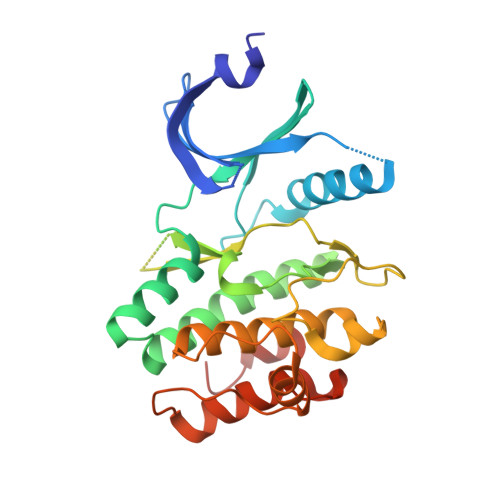Synthesis and structure-activity relationships of N-6 substituted analogues of 9-hydroxy-4-phenylpyrrolo[3,4-c]carbazole-1,3(2H,6H)-diones as inhibitors of Wee1 and Chk1 checkpoint kinases.
Smaill, J.B., Baker, E.N., Booth, R.J., Bridges, A.J., Dickson, J.M., Dobrusin, E.M., Ivanovic, I., Kraker, A.J., Lee, H.H., Lunney, E.A., Ortwine, D.F., Palmer, B.D., Quin, J., Squire, C.J., Thompson, A.M., Denny, W.A.(2008) Eur J Med Chem 43: 1276-1296
- PubMed: 17869387
- DOI: https://doi.org/10.1016/j.ejmech.2007.07.016
- Primary Citation of Related Structures:
2IN6, 2IO6 - PubMed Abstract:
A series of N-6 substituted 9-hydroxy-4-phenylpyrrolo[3,4-c]carbazole-1,3(2H,6H)-diones were prepared from N-substituted (5-methoxyphenyl)ethenylindoles. The target compounds were tested for their ability to inhibit the G2/M cell cycle checkpoint kinases, Wee1 and Chk1. Analogues with neutral or cationic N-6 side chains were potent dual inhibitors. Acidic side chains provided potent (average IC(50) 0.057 microM) and selective (average ratio 223-fold) Wee1 inhibition. Co-crystal structures of inhibitors bound to Wee1 show that the pyrrolo[3,4-c]carbazole scaffold binds in the ATP-binding site, with N-6 substituents involved in H-bonding to conserved water molecules. HT-29 cells treated with doxorubicin and then target compounds demonstrate an active Cdc2/cyclin B complex, inhibition of the doxorubicin-induced phosphorylation of tyrosine 15 of Cdc2 and abrogation of the G2 checkpoint.
- Auckland Cancer Society Research Centre, School of Medical Sciences, The University of Auckland, Private Bag 92019, Auckland 1020, New Zealand. j.smaill@auckland.ac.nz
Organizational Affiliation:

















